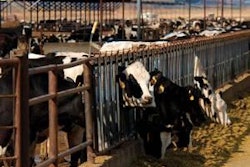.jpg?auto=format%2Ccompress&q=70&w=400)
A complete contrast has appeared in Denmark this year to the usual picture of extrusion as presenting a challenge to heat-sensitive ingredients. Extruded material features in a newly launched process for the protection of vitamins and minerals to include in the diet.
Details were revealed at the 2007 edition of the Agromek farm machinery show held in Herning, Denmark. A display by Danish exhibitor Vitfoss centred on its adoption of the new processing method to produce vitamin/mineral compounds in the shape of tiny disc-shaped prills.
The method itself has been devised by Danish engineer Dan Edberg. Working in collaboration with the national institute of technology, he wanted to find a way of encapsulating micro-ingredients so that they would be less dusty, easier to mix uniformly and more likely to survive an exposure to high temperatures during feed manufacture. His solution based on modified extrusion is currently the subject of a patent application.
In essence the procedure marries vitamins and minerals to a glue of wheat starch before pressing the mixture through a die into discs varying in diameter from 3mm to 5mm. Its first step takes wheat and water into an extruder for gelatinisation of the starch. After the material has become elastic and adhesive, however, the extruder's vent is opened to drop the pressure. This lowers the temperature in the machine to around 60°C so that heat-sensitive products can be added and mixed without degradation. Finally the mixture is pressed, cut into prills and cooled ready for loading into the big bags in which it will be delivered to mills and on-farm feed mixers.
"We call the result of processing a form of encapsulation," said Vitfoss head of nutrition Hans Aae at Agromek. "The starch glue between and around the sensitive materials acts as a protective capsule. The original idea was to make a big pellet with an edible shell around the feed, but we found the smaller pellets worked better by effectively encapsulating more of the vulnerable ingredients. The protection has meant that a greater share of the minerals included in the feed actually reaches the animal to improve its performance.
"Our agreement with the originator of the process covers its use in Scandinavia and Germany in relation to the feeding of production animals. Mr. Edberg's company retains the right to sell it elsewhere and for other species. Vitfoss is currently installing the new equipment to be fully operative by April 2007 for producing our new Vitacaps products. These are highly concentrated in containing 80-85 percent of the primary products with 15-20 percent of the gelatinised wheat starch. They save costs by supporting a change in minerals handling from bags to bulk while also avoiding the demixing that can occur when particles of different sizes pass along a normal production line."



.jpg?auto=format%2Ccompress&fit=crop&h=167&q=70&w=250)













